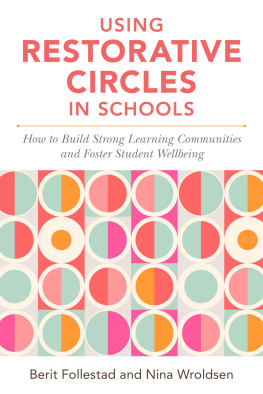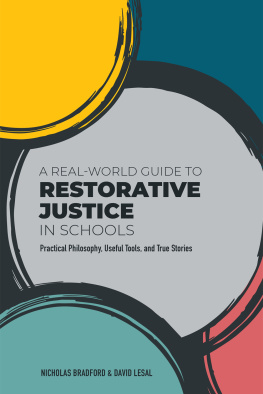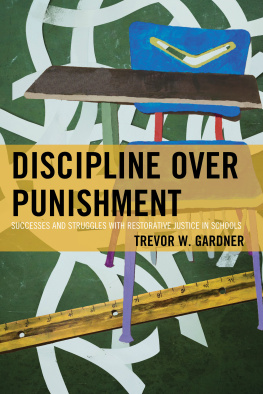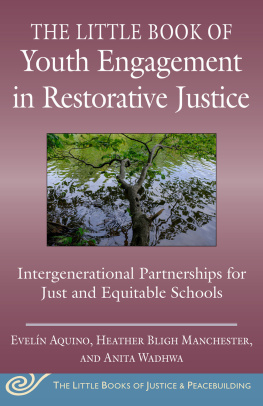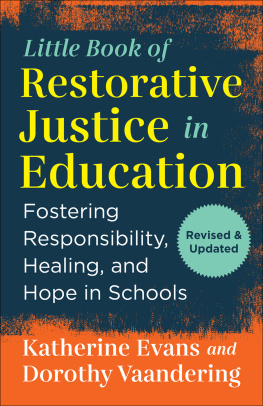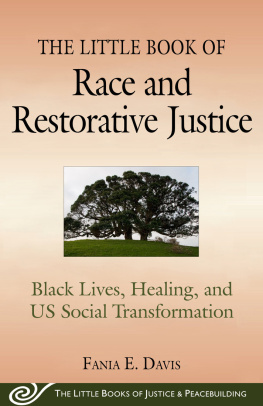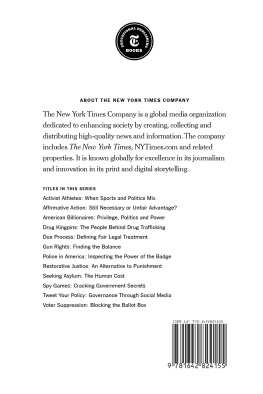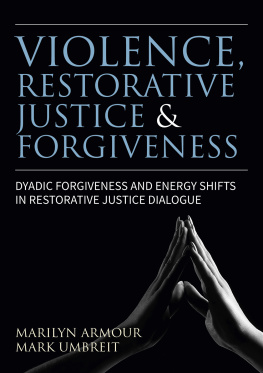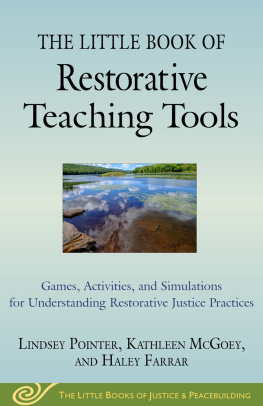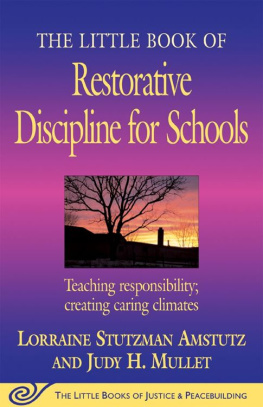
Using Restorative
Circles in Schools
How to Build Strong Learning Communities
and Foster Student Wellbeing
BERIT FOLLESTAD AND NINA WROLDSEN
Foreword by Belinda Hopkins

Jessica Kingsley Publishers
London and Philadelphia
Contents
Foreword
Belinda Hopkins
It has been an honour and delight to work with Berit and Nina over the years, sharing our enthusiasm for restorative approaches at many of the stimulating conferences run by Tryglarung, the organisation they co-founded with other passionate Norwegian educators. These conferences have always been joyful events, which usually begin by using circle process with everyone present to build a bonded learning community amongst conference participants. In other words the authors have demonstrated how well circle activities can work to break down isolation between people who have not previously met, how shared fun and laughter can create connections between people, how opportunities to participate in pair and group discussions can help people overcome their nerves at meeting new people. How wonderful it would be if all conferences began in this way!
It is with great pleasure that I am now able to support them further by encouraging people to read their book on restorative circles. This is a book that has grown out of their experience implementing restorative practice in many schools across Norway. This experience shines through, not only in their anecdotes and confident explanation of how to facilitate circles of different sorts but also from their deeply grounded understanding of why these practices are so needed, not just in Norway but in schools across the globe.
The book is timely the health and wellbeing of young people, and of those who work with them, is a live issue, as is the continued concern about the safety of young people as bullying, violence and radicalisation threaten their daily lives in and out of school. Nina and Berit also explain the importance of the psychosocial environment on learning, an issue that again becomes ever more important to educators as our understanding of brain development increases.
The book advocates using circles of all sorts to build strong caring communities within classrooms, and amongst staff teams, and thereby create the foundations on which a school culture based on relationships and connection can be constructed. Berit and Nina share ideas for games and lively activities that encourage participants moving around, sitting next to and talking to different people, working in pairs and small groups and always coming back to the full circle to reflect on what has been enjoyed and learned. These activities develop a range of relationship skills that can then be harnessed, if and when necessary, to put things right when they go wrong.
In light-hearted ways pro-active circles provide an opportunity for people learn to listen to what others are saying; reflect back what they have heard; develop empathy and understanding for what it is like to see the world differently; to develop a vocabulary of express emotions and needs; to practice negotiation and co-operation and to experience the joy of feeling included and connected. And these are the very skills that will be needed to put matters right when they go wrong and to repair the harm done to the complex weave of relationships that make a school a safe caring place. This book provides plenty of examples of how to create the foundational elements of a restorative school the values, the principles and the skills and also examples of how these values, principles and skills can be used to address challenges and conflicts.
The book provides very practical ideas to classroom teachers. Perhaps I can offer some hints for the school leaders who will be creating the framework in which their staff can run the circles.
I have been privileged to support inspirational school leaders to introduce restorative approaches in their schools and travel with them along their implementation journey over many years. I have seen how vital the role of the senior leadership team is in setting the example themselves using circles for their own team meetings, and encouraging departments or facilities to also hold meetings in circle. The key to success here is every participant abiding by the talking piece rules the piece passing around with the sun (clock-wise) as Berit and Nina describe it, with no-one talking if it is not in their hand, no-one interrupting until the piece comes back to them around the circle and crucially, listening with an open mind and an open heart to whatever is being said. This is not about agreeing with all that is said necessarily, but about being open to appreciating differing perspectives and seeking to understand why someone may have a different view from ones own. Countless school professionals have told me how this regular practice with colleagues has transformed their team culture.
The second hint for school leaders is make it possible for circles to happen and support those members of staff who are not natural facilitators. Perhaps alter the school timetable as some schools do to allow for weekly circles to take place. Encourage staff to share their circle programmes and ideas so that creating them does not become another onerous task. Sit in with timid or more traditional members of staff for whom facilitating a circle may feel initially worse than having deep root canal dental treatment and co-facilitate until they feel more confident or more convinced.
A third hint would be to make explicit links between your Teaching and Learning Policy and the active, participative techniques of circle practice. Negotiation, dialogue, collaboration, pair and group work these are all tried and tested pedagogical techniques and circle process utilises them all. Also emphasis the affective domain good teaching and learning harnesses the thoughts, feelings and needs of all learners and so it is possible to bring so-called restorative questions into academic teaching. Offer in-service guidance so that all staff can make these links.
Fourthly establish a staff committee to support their colleagues in implementing circles and check-in with what extra support, information, resources or training might be needed to keep up the momentum. This committee can also monitor the impact of regular circles on staff and student health and wellbeing, engagement, motivation and happiness.
And finally buy a copy of this book for every department or faculty or better still for every member of your staff! It would be an investment you will not regret and your staff and students will thank you for it.
Dr Belinda Hopkins
Director of Transforming Conflict, the National Centre for
Restorative Approaches in Youth and Community Settings
www.transformingconflict.org
Introduction
Put simply, a restorative circle is a community process for supporting the members of a group, which facilitates communication based on dialogue and active, equal participation.
Restorative circles in schools provide participating individuals with time and space to listen, and with opportunities to develop their attention span and oral communication, and to learn new concepts and skills. They can also be used to explore auditory memory and sensory experiences, to encourage socialisation and, importantly, to have fun!
When used in the right way, they can be used as a tool to help to create safe and inclusive learning environments.
WHY THIS BOOK?
We decided to write this book because we want to share our experience with the use of restorative practices and to give the reader an introduction to a theoretical and practical framework for building and repairing strong working relations between students and between students and teachers. This book presents the reader with an accessible explanation of restorative thinking along with practical methods that can be used both proactively and reactively.
Next page
